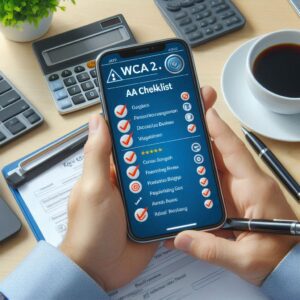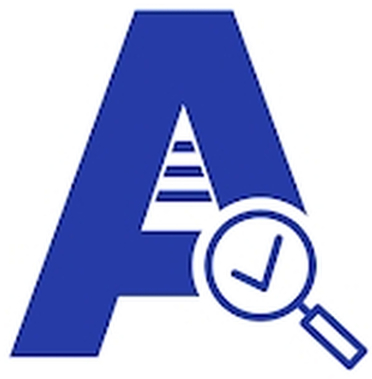WCAG 2.1 AA Checklist
A WCAG 2.1 AA Checklist helps ensure that websites and digital content meet accessibility standards, providing an inclusive experience for all users, including those with disabilities. You can create this checklist using eAuditor Audits & Inspections to track compliance with Web Content Accessibility Guidelines (WCAG) 2.1 at the AA level.

Here’s a structured WCAG 2.1 AA Checklist designed for use in eAuditor Audits & Inspections:
WCAG 2.1 AA Checklist (eAuditor Audits & Inspections)
1. Perceivable
1.1 Text Alternatives (1.1.1 Non-text Content)
- Are text alternatives provided for all non-text content (images, icons, buttons, etc.)?
- Yes / No / N/A
- Are complex images (graphs, charts) provided with detailed descriptions or alternatives?
- Yes / No / N/A
1.2 Time-Based Media
- 1.2.1 Is there a text alternative for pre-recorded audio-only content?
- Yes / No / N/A
- 1.2.2 Are captions provided for pre-recorded video content?
- Yes / No / N/A
- 1.2.3 Is there an audio description or alternative for pre-recorded video content?
- Yes / No / N/A
- 1.2.5 Are audio descriptions provided for live video?
- Yes / No / N/A
1.3 Adaptable Content
- 1.3.1 Is content structured with proper headings (H1, H2, etc.), lists, and landmarks?
- Yes / No / N/A
- 1.3.2 Does content make sense in different layouts, without losing information?
- Yes / No / N/A
- 1.3.3 Are instructions not reliant on sensory characteristics (e.g., “click the red button”)?
- Yes / No / N/A
1.4 Distinguishable
- 1.4.3 Does the color contrast between text and background meet the minimum 4.5:1 ratio?
- Yes / No / N/A
- 1.4.4 Can text be resized up to 200% without loss of functionality?
- Yes / No / N/A
- 1.4.5 Are text images used sparingly, only when necessary?
- Yes / No / N/A
- 1.4.10 Is there enough spacing between text, paragraphs, and lines to ensure readability?
- Yes / No / N/A
- 1.4.11 Does the color contrast between UI elements and their background meet the minimum 3:1 ratio?
- Yes / No / N/A
2. Operable
2.1 Keyboard Accessibility
- 2.1.1 Can you access all functionality with keyboard only(no mouse required)?
- Yes / No / N/A
- 2.1.2 Are there no keyboard traps (keyboard focus cannot be moved to or from certain elements)?
- Yes / No / N/A
2.2 Enough Time
- 2.2.1 Are time limits adjustable or extendable where applicable (e.g., forms, quizzes)?
- Yes / No / N/A
- 2.2.2 Can users pause, stop, or hide automatically moving, blinking, or scrolling content?
- Yes / No / N/A
2.3 Seizures and Physical Reactions
- 2.3.1 Is there no content that flashes more than three times per second?
- Yes / No / N/A
2.4 Navigable
- 2.4.1 Is there a “Skip to Content” link or similar functionality for screen readers?
- Yes / No / N/A
- 2.4.2 Do pages have clear titles that describe their purpose or content?
- Yes / No / N/A
- 2.4.3 Is focus order logical and consistent when using a keyboard for navigation?
- Yes / No / N/A
- 2.4.4 Are there visible focus indicators when navigating with a keyboard?
- Yes / No / N/A
- 2.4.5 Do all links have meaningful and descriptive text (no “Click here” or “Read more” links)?
- Yes / No / N/A
- 2.4.6 Are headings and labels clear and descriptive for their purpose?
- Yes / No / N/A
- 2.4.7 Is there more than one way to locate a page within a website (search, site map, etc.)?
- Yes / No / N/A


3. Understandable
3.1 Readable
- 3.1.1 Is the primary language of the page indicated using language tags?
- Yes / No / N/A
- 3.1.2 Are any changes in language within the content properly identified?
- Yes / No / N/A
3.2 Predictable
- 3.2.1 Do elements like buttons, links, or form inputs behave consistently?
- Yes / No / N/A
- 3.2.2 Does the page avoid unexpected changes of context (e.g., pop-ups) when input is received?
- Yes / No / N/A
- 3.2.3 Are navigation mechanisms (menus, links) consistent across the site?
- Yes / No / N/A
3.3 Input Assistance
- 3.3.1 Are input errors clearly identified and explained to the user?
- Yes / No / N/A
- 3.3.2 Are suggestions provided to fix errors in forms or inputs?
- Yes / No / N/A
- 3.3.3 Are there clear instructions for all forms and input fields?
- Yes / No / N/A
4. Robust
4.1 Compatible
- 4.1.1 Is HTML code valid and free from errors or accessibility issues?
- Yes / No / N/A
- 4.1.2 Are all interactive elements (buttons, links, forms) accessible through assistive technology (e.g., screen readers)?
- Yes / No / N/A
4.2 Name, Role, Value
- 4.1.2 Is the name, role, and state of UI elements (buttons, checkboxes, etc.) programmatically determined and communicated to assistive technology?
- Yes / No / N/A
Additional Notes:
- Use the camera or attach screenshots to document specific issues or instances of non-compliance.
- Record any accessibility issues and assign corrective actions to team members with due dates.
Corrective Actions:
- List all areas of non-compliance, the team responsible, and the actions needed to rectify the issue.


WCAG 2.1 AA Checklist covers key WCAG 2.1 AA success criteria and can be customized in eAuditor Audits & Inspections with form fields, drop-down options, and scoring mechanisms for different content sections. It’s an efficient way to track your website’s accessibility compliance and ensure it meets legal and ethical standards.
Conducting a WCAG 2.1 AA Compliance Inspection using eAuditor Audits & Inspections WCAG 2.1 AA Checklist helps ensure that a website or digital product meets accessibility standards, providing an inclusive experience for users with disabilities.
WCAG (Web Content Accessibility Guidelines) 2.1 focuses on four key principles: Perceivable, Operable, Understandable, and Robust. Here’s how you can structure an inspection for WCAG 2.1 AA compliance:
1. Prepare the Inspection Checklist
- Select or Create a Template: Use a pre-existing WCAG 2.1 AA Checklist on eAuditor Audits & Inspections or create a custom WCAG 2.1 AA Checklist that covers the key criteria for Level AA compliance.
Key Areas to Include in the Checklist:
A. Perceivable:
B. Operable:
C. Understandable:
D. Robust:
2. Conduct the Inspection
- Use eAuditor Audits & Inspections to systematically test the website or app. Go through each section of the checklist and verify the corresponding WCAG 2.1 AA compliance criteria.
- You can use accessibility tools and plugins (e.g., WAVE, axe, Lighthouse) to support manual checks for compliance, and note any issues in eAuditor Audits & Inspections.
- Take screenshots or notes for areas of concern and document any non-compliance.
3. Report Findings
- Once the inspection is complete, generate a detailed report using eAuditor Audits & Inspections, summarizing:
- Areas of non-compliance.
- Severity of the issues (minor, moderate, critical).
- Recommendations for corrective actions.
- Include priority actions to resolve critical issues that may impact accessibility for users with disabilities.
4. Action Plan and Follow-Up
- Assign corrective actions to responsible team members with deadlines.
- Conduct follow-up inspections after the issues have been resolved to ensure the website meets WCAG 2.1 AA compliance standards.
Regular audits and using tools like eAuditor Audits & Inspections ensure that your digital products are accessible to a wider audience and comply with legal and ethical standards.
